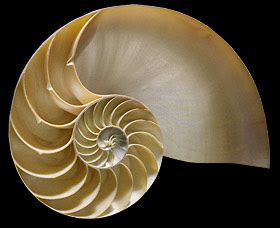WEEK 2: MATH AND ART
I came across the golden number in high school when I had to
come up with a topic in mathematics to explore. Our book was exploring the
common misconception that Nautilus shell is a golden spiral (a spiral that gets
wider with the factor of the golden ratio).
 |
| Nautilus Shell |
 |
| Golden Spiral |
Although this is an example of a misconception, there are indeed many examples of mathematical patterns in the nature. One great example would be the fractal geometry of snowflakes. So it is only natural to assume that art, which often takes inspiration from nature, would have a deep influence from mathematics. However, the progression of this influence, which was explored in this lecture, is something very interesting to learn about.
Marc Frantz lecture on vanishing points is one of the best
examples of math in art. The use of “vanishing points” to accurately represent three-dimensional
shapes in paintings is amazing. The video about the presence of the Fibonacci
sequence in financial markets is very intriguing.
 |
| Cycle by Escher |
The use of mathematics in art, as exemplified by Escher,
seems to only elevate the artwork and the message it is trying to express.
References:
1. Meisner, Gary. "Is The Nautilus Shell Spiral A Golden Spiral?". Goldennumber.net. N.p., 2017. Web. 16 Apr. 2017.
References:
1. Meisner, Gary. "Is The Nautilus Shell Spiral A Golden Spiral?". Goldennumber.net. N.p., 2017. Web. 16 Apr. 2017.
2. "Fractals - Mandelbrot". YouTube. N.p., 2006. Web. 16 Apr. 2017.
3. Frantz, Marc. "Lesson 3: Vanishing Points And Looking At Art". N.p., 2000. Web. 16 Apr. 2017.
4. "Fibonacci, Fractals And Financial Markets - Socionomics.Net". YouTube. N.p., 2007. Web. 16 Apr. 2017.
5. "The Mathematical Art Of M.C. Escher". Platonicrealms.com. Web. 16 Apr. 2017.



Comments
Post a Comment